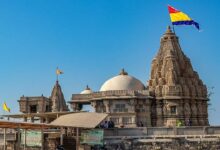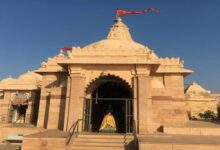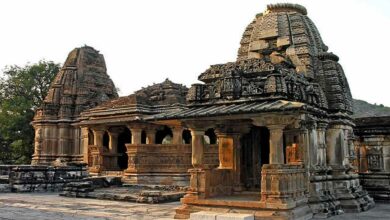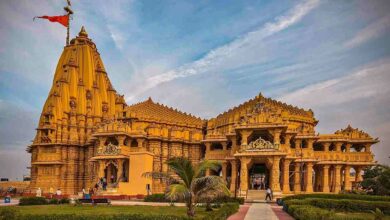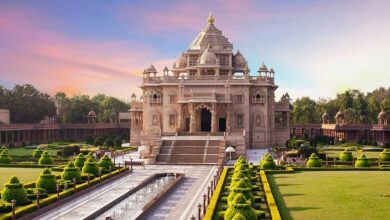Sarnath Temple: This ancient pilgrimage temple of Varanasi is famous not only in the country but all over the world
Sarnath Temple: The Varanasi area of the state of Uttar Pradesh is home to the Sarnath Temple, a significant Buddhist pilgrimage destination. This hallowed location is where Lord Buddha delivered his first lecture upon enlightenment, known as “Dharmachakra Pravartan.” Devotees and visitors from all over the globe come to Sarnath to connect with the profound teachings of Buddhism because of the place’s incredible tranquility and serenity.

In addition to being significant from a religious and historical perspective, Sarnath is also a fascinating location from an archeological one, since excavations have revealed Buddha-era relics. The temple is a great spot for meditation and introspection because of its serene ambiance and spiritual aura. Sarnath Temple: What is it? What is the Sarnath Temple’s history? We all have a lot of questions about the significance and characteristics of the Sarnath Temple. The history of the Sarnath Temple, its religious and mythical importance, how to get there, and the well-known locations in the Sarnath area will all be covered in length in this article.
Sarnath Temple: Overview
Sarnath is a historic and significant holy site in Uttar Pradesh’s Varanasi district. It is renowned worldwide for the occasion of “Dhammachakra Pravartan” (setting the wheel of religion) and is one of the four main Buddhist pilgrimage places. In his first discourse, Mahatma Buddha introduced the eightfold path and the four noble truths. In addition, Sarnath is significant to Jainism since it is said to be the birthplace of Shreyansanath, the eleventh Jain Tirthankara. The historical grandeur of this location is brought to life via museums, temples, stupas, and archaeological remains. This location is a representation of knowledge, peace, and cultural diversity.
Sarnath’s Past
Sarnath was once known as “Isipatan” (Rishipatan), which translates to “place of sages.” In the past, sages and munis are said to have meditated here. Buddhist traditions state that Gautam Buddha delivered his first sermon to the Panchvargiya monks at Bodh Gaya in 528 BC after achieving enlightenment, which resulted in the founding of the Buddhist Sangha.
After embracing Buddhism, Emperor Ashoka made Sarnath a significant pilgrimage destination. Here, he built the Dhamek Stupa and Ashoka Pillar, where the etched figure of four lions became India’s national emblem. Following this, Sarnath saw more enrichment throughout the Gupta era. Numerous opulent temples and viharas were constructed during this time. In his travelogue from the 7th century, Chinese traveler Hiuen Tsang said that Sarnath had 3000 monks and 30 Buddhist monasteries.
However, Sarnath was abandoned for many years after being devastated by Turkish invaders in the 12th century. British researchers unearthed the ancient remains during an excavation in the 19th century. In addition to being a significant religious site, Sarnath is also regarded as being of utmost historical and archeological significance.
Religious importance
- Since Lord Buddha introduced the eightfold path and the four noble truths in his first discourse, Sarnath is a significant Buddhist hub. It is known as the “Dharmachakra Pravartan Sutra,” and it was from this discourse that the Buddhist Sangha was founded. For Buddhists, this location is just as significant as Lumbini, Bodh Gaya, and Kushinagar. The teachings of Buddha are preserved in these stupas and temples.
- Since Sarnath is said to be the birthplace of the eleventh Tirthankara Shreyansnath, it is also a particularly significant site for Jainism. For those who practice Jainism, this location is a haven of calm and spirituality. This area is home to Jain temples where Shreyansnath statues are housed. Numerous Jain scriptures also make reference to this location, demonstrating its historical significance.
- Sarnath is linked to Hinduism even though it is mostly a Buddhist pilgrimage destination. Here, the Mulagandha Kuti Vihara showcases a fusion of Buddhist and Hindu design. In addition to this, some old temples include idols of Hindu deities. As a result, Sarnath represents the cultural legacy of several faiths.
Characteristics of Religious Places
Dhamek Stupa:
This stupa has a diameter of around 28 meters and a height of about 43 meters. Emperor Ashoka constructed it, and the Gupta era saw its reconstruction. It was here that Lord Buddha delivered his first sermon.
Ashoka Pillar:
One of Sarnath’s main attractions is the Ashoka Pillar, which was constructed by Emperor Ashoka. On top of it stands a statue of four lions, which is regarded as India’s national emblem. Engraved in Brahmi characters on this pillar are the tenets of Buddhism.
Moolgandha Kuti Viharaya:
The Buddhist community of Sri Lanka constructed this exquisite vihara in 1931. It has a massive golden statue of Lord Buddha and Sri Lankan-style architecture.
Sarnath Museum:
Ancient Buddha sculptures, the original lion capital of the Ashoka Pillar, and other historical artifacts may be found in the Sarnath Museum, one of India’s oldest museums.
Chaukhandi Stupa:
The Panchvargiya monks first encountered Lord Buddha at this mound. It was given a square foundation during the Mughal era, earning it the moniker “Chaukhandi Stupa.”
How do I go to Sarnath?
Air:
Lal Bahadur Shastri International Airport in Varanasi, which is around 35 kilometers from Sarnath, is the closest airport. From here, it’s easy to take a taxi or cab to Sarnath.
Rail:
Varanasi Junction, the closest train station to Sarnath, is just 10 kilometers away. From here, it’s easy to go to Sarnath by bus, cab, or autorickshaw. One of India’s main train terminals, Varanasi Junction, has excellent connections across the nation.
Road:
Sarnath has road access to the main cities of Bihar and Uttar Pradesh. There are public and private buses, taxis, and autorickshaws that go from Varanasi to Sarnath. By road, Sarnath is also conveniently accessible from Patna, Prayagraj, Gorakhpur, and Lucknow.
A Succinct Conclusion
History, religion, and culture all come together at the pilgrimage site of Sarnath. It is a popular destination for visitors and history buffs in addition to Buddhists. By designating it as a World Heritage Site, UNESCO has further elevated its significance. In the calm setting of Sarnath, the reverberation of Buddha’s teachings may still be heard.
Conclusion: Temple of Sarnath
We really hope you enjoyed this piece we wrote on the reasons behind Sarnath Temple’s fame. Please use the comment section if you have any questions or suggestions, and we will do our best to respond as quickly as we can. Visit our website for more fascinating stories like this one. Again, thank you. Jan Bhakti
FAQs: Temple of Sarnath
Q. What is the location of Sarnath?
A. Sarnath, one of the main Buddhist pilgrimage destinations, is situated in the Varanasi district of Uttar Pradesh.
Q. What was Sarnath’s ancient name?
A. Sarnath was once known as “Isipatan” (Rishipatan), which translates to “place of sages.”
Q. What is the significance of Sarnath in Buddhism?
A. Sarnath has significance as the location of Mahatma Buddha’s first discourse, known as “Dharmachakra Pravartan.”
Q. Who constructed the Dhamek Stupa?
A. Emperor Ashoka constructed the Dhamek Stupa, which underwent renovations throughout the Gupta era.
Q. What role does the Ashoka Pillar play?
A. On the Ashoka Pillar, which has been designated as India’s national emblem, has a statue of four lions.
Q. What makes Sarnath significant to Jainism?
A. The 11th Tirthankara, Shreyansnath, is said to have been born at Sarnath, which makes it significant for Jainism.
